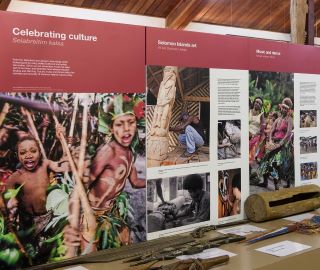History of the Solomon Islands

It is believed that at least 30,000 years ago, the first Papuan settlement from New Guinea happened in the Solomon Islands. Most of the languages spoken in the Solomons derive from this era.
Spanish explorer Alvoro de Mendana was the first European to officially sight the islands and found signs of gold on Guadalcanal. He believed he had found the source of King Solomon’s wealth and named the islands ‘The Island of Solomon’. In 1595 and 1605, Spain sent several more expeditions to find the islands and establish a colony but these attempts were unsuccessful. In 1767, the British discovered Santa Cruz Island and Malaita. By 1900 the Solomon Islands were a British protectorate.
World War II History
The Solomon Islands was the scene of a major campaign in World War II. The campaign began with Japanese landings in several areas in the British Solomon Islands and Bougainville in the Territory of New Guinea during the first six months of 1942.
The Japanese occupied these locations and began the construction of several naval and air bases to protect their ground. The Allied forces of the United States of America, Australia & New Zealand launched a counter-offensive in New Guinea, isolated the Japanese base in Rabaul and attacked the Japanese in the Solomons.
Many battles followed and the Allies eventually wore down the Japanese, inflicting significant losses on the Japanese military assets. For 6 months between 1942 and 1943, the Solomon Islands was the setting for almost constant combat, typically referred to as the Battle of Guadalcanal and is said to be a turning point in the war.
Henderson Field (Now Honiara International Airport)
Henderson Field was originally built during World War II by the Japanese and is a former military airfield. The construction was ahead of schedule and on 6 August 1942 the construction troops were given an extra ration of sake to finish ahead of schedule.
On 7 August 1942, the Americans arrived. The field had not been completed and they overwhelmed the Japanese defenders and moved to quickly finish building it so that their planes could be based there. The airfield as named Henderson Field in honour of Major Lofton Henderson, a commanding officer who was killed during the Battle of Midway, becoming the first marine to perish during the battle.
The US Marines continued to defend Henderson Field because the Japanese recognised how vital the area was. But the Japanese under-estimated how many Americans were on the island. At first, the Japanese withdrew and then at 1.30am 100 Japanese soldiers charged. The fighting lasted about an hour and the Americans overwhelmed the Japanese. A second attack by the Japanese was launched shortly after and once again they were defeated. However the Japanese were not willing to give up and they looked for alternative ways of attack. After advancing from the water, they were defeated for a third time. The fighting continued throughout the day and the Japanese had their backs to the sea. After a day of intense fighting, the Marines had defeated the Japanese.
After the war, Henderson Field was abandoned an after some modernisation, it was reopened in 1969 as Honiara International Airport.
Post War
Stability was restored to the Solomon Islands in the 1950’s as the British established a network of official local councils and islanders started participating in central government. The first national election was held in 1964 in Honiara and in 1967 the first general election was held.
In 1974, the Westminster form of government was introduced.
The financial costs of supporting the Solomon Islands became difficult for the British as the world economy suffered high oil prices in 1973. Self-government was granted in January 1976 and independence granted on 7 July 1978 and Sir Peter Kenilorea became the first Prime Minister of the Solomon Islands.
In 1999, tribal rivalries erupted in the capital and in 2003 Australia, New Zealand, Fiji and Papua New Guinea sent help to negotiate peace and security. Assistance is provided by those countries today but there is now a focus on community policing and developing local industries sustainably.
The Solomons Islands today
The impact of WWII on the islands and the people of the Solomons was significant. There are remnants of the war almost everywhere – today you will see relics scattered in the jungle, off the beach and at the bottom of the ocean. These remnants make our island a perfect destination for history buffs, divers and eco-tourists alike.
Attractions
National Museum and Cultural Centre

The National Museum is modest but still worth a visit, for a taste of the history of the Solomon Islands. With exhibitions that traverse history and the diverse cultures that make up its almost 1000 islands, you can view old photographs, currency, weaponry and find out more about the history of World War II and the missionaries, both of which are core to the current national identity and way of life.
Peter Joseph WWII Museum

During World War II, Munda was a vital military airfield base and remnants are scattered throughout the region. You can visit two small private museums of WWII relics. One is the Peter Joseph WWII Museum and the other is further east. Both are walkable from Agnes Gateway Hotel and accommodation in town or easily accessible by taxi.
